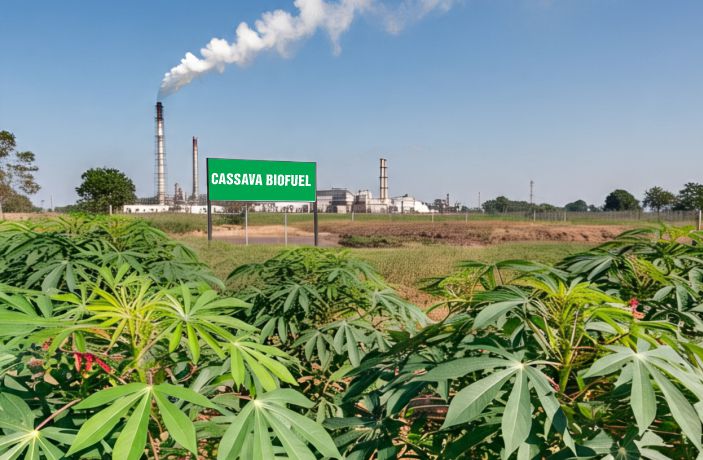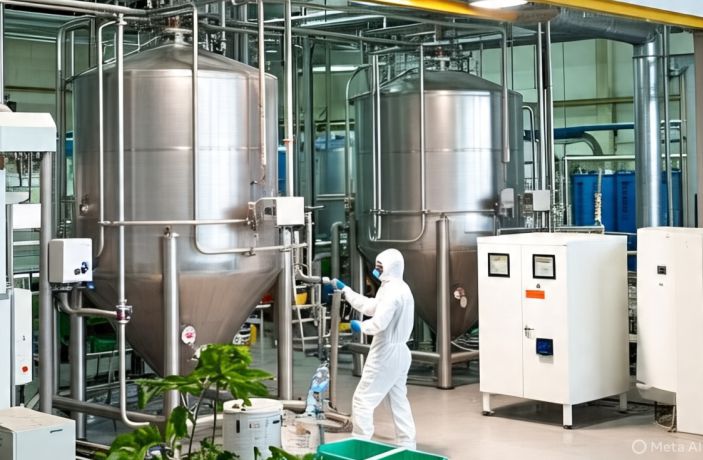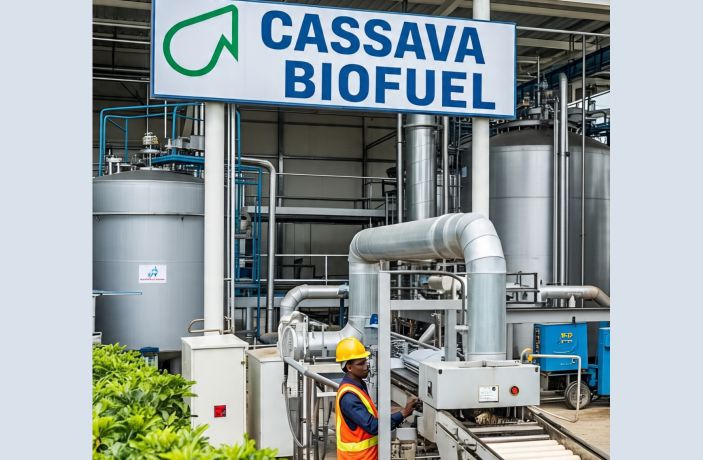Cassava biofuel offers a sustainable energy alternative, reducing carbon footprints while enhancing energy security and rural development. Discover its potential!
Cassava biofuel offers a sustainable energy frontier rooted in agriculture, turning starch-rich roots into clean fuel while empowering farmers and reducing dependence on fossil fuels. Discover its full potential.
Its high starch yield, short growth cycle, and ability to grow in poor soils make it a strong feedstock for fuel and business alternatives.
With minimal input requirements, the cassava plant supports cost-effective energy generation, especially in regions with limited resources.
It also offers opportunities for rural development by creating jobs, increasing income for farmers, and promoting waste reuse through by-products like animal feed and organic fertilizer.
Cassava can be cultivated on marginal lands, helping avoid competition with food crops while increasing land use efficiency.
As global energy demands rise, cassava-based biofuels provide a sustainable path for cleaner fuel production, especially in tropical and subtropical climates.
This page covers the key applications, benefits, production processes, challenges, and market potential of cassava biofuels.
Recommended: How to Write a Cassava Business Plan
Table of Contents
- Main Points
- What is Cassava Biofuel?
- Understanding the Terms: Biofuel, Bioethanol, Biodiesel, Biogas, and Biomass
- Types of Cassava Biofuels
- Cassava Biofuel Production Process
- Cassava Biofuel in the Cassava Value Chain
- Global Cassava Biofuel Production
- Economic Benefits of Cassava Renewable Energy
- Environmental and Economic Impact
- Challenges of Cassava Biofuel Development
- Future Prospects and Innovations
- Cassava Biofuel vs Other Feedstocks
- Case Studies of Successful Cassava Biofuel Initiatives
- Frequently Asked Questions
- Conclusion
Main Points
- Cassava biofuel includes cassava bioethanol and cassava biogas, made from starch-rich roots and waste through fermentation and anaerobic digestion.
- Cassava biofuel benefits from cassava’s high starch yield and low input needs, making it ideal for bioethanol and biogas production.
- By converting cassava waste into biogas, cassava biofuel reduces environmental impact and improves rural energy access using local resources.
- Cassava biofuel boosts rural development by creating jobs, increasing farmer income, and promoting local fuel solutions in underdeveloped regions.
- Technological advances in cassava biofuel, like new cassava strains and decentralized processing, enhance energy efficiency and availability in remote communities.
What is Cassava Biofuel?
Cassava biofuel is a renewable energy produced from the cassava plant, mainly using its starch-rich roots and processing by-products. The starch is fermented to create cassava ethanol, a clean-burning fuel that can be blended with gasoline.
In addition to ethanol, cassava waste, such as peels, pulp, and wastewater, can be processed through anaerobic digestion to produce biogas for cooking and electricity.
There is also ongoing research into producing biodiesel from cassava seed oil, although this is still in development.
Because cassava grows well in poor soils with minimal inputs, it offers an accessible and locally sourced option for biofuel production, especially in regions with limited access to conventional energy sources.
Understanding the Terms: Biofuel, Bioethanol, Biodiesel, Biogas, and Biomass

When you’re working with cassava for renewable energy, it’s important to know what each fuel type really means.
These terms aren’t just technical labels; they shape how energy is produced, used, and valued.
Whether you’re developing a project, planning investments, or simply exploring cassava’s energy potential, this breakdown will help you understand how bioethanol, biodiesel, biogas, and biomass fit into the bigger picture of biofuel production.
Biofuel: The Big Picture
Biofuel is the general term for any fuel made from biological sources. This includes fuels produced from plants, farm waste, or animal by-products.
You can use biofuels to power vehicles, generate electricity, or heat homes.
The goal is to replace fossil fuels with cleaner, renewable energy. Common types include bioethanol, biodiesel, and biogas.
Biofuel covers all of these, making it the top-level category.
Bioethanol: Fuel from Fermenting Sugars
Bioethanol is a renewable liquid fuel produced by fermenting the sugars or starches found in crops such as cassava, corn, sugarcane, or wheat.
It is widely used as a cleaner alternative to gasoline, either as a standalone fuel or blended with petrol.
Because it burns with fewer emissions, bioethanol helps reduce air pollution and dependence on fossil fuels.
Cassava is especially valuable in this process because of its high starch content and low input needs.
Most ethanol used in transport today comes from plant-based sources, placing bioethanol at the center of many national biofuel strategies and energy policies.
Biogas: Fuel from Processing Bio Waste
Biogas is a renewable fuel made when organic matter breaks down in the absence of oxygen, a process called anaerobic digestion.
During this process, microbes digest plant waste and release a gas rich in methane, which can be used for cooking, heating, or generating electricity.
Cassava ties into this through the large amount of organic waste it produces during processing.
Peels, pulp, and starchy wastewater from cassava can all be fed into biodigesters to produce biogas.
Biomass: The Raw Material Behind Many Biofuels
Biomass refers to organic material that comes from plants and animals, and it’s one of the oldest energy sources used by humans.
In the context of biofuels, biomass includes agricultural residues, wood, and crops like cassava.
When processed, biomass can be converted into fuels such as biogas, bioethanol, or solid briquettes. Cassava contributes to biomass through its peels, stems, and other by-products left after harvest or processing.
These materials are either burned directly or broken down biologically to release energy.
Using biomass helps reduce waste and offers a renewable, locally available source of fuel for rural and urban areas alike.
Biodiesel: Fuel from Plant or Animal Oils
Biodiesel is a renewable fuel made by processing natural oils or fats, such as palm oil, soybean oil, or even used cooking oil, through a chemical process called transesterification.
Unlike bioethanol, which comes from sugars or starch, biodiesel is made from lipids.
It can power diesel engines in cars, trucks, and generators with lower carbon emissions than petroleum diesel.
While cassava isn’t a direct source of biodiesel, it supports the industry by freeing up other feedstocks (like palm oil) and integrating into biodiesel systems through co-products and energy farming strategies.
Related Posts
- Guide to the Cassava Industry
- What is Resistant Tapioca Starch?
- The Six Industrial Benefits of Cassava
- How to Remove Cyanide from Cassava Roots
- How to Process Cassava
- Modern Equipment for Processing Cassava
- Understanding the Cassava Pulp Market
Types of Cassava Biofuels

Cassava gives you more than food; it offers clean fuel alternatives. You can turn its starch, waste, and even its biomass into different biofuels that support energy needs in simple, local ways.
Let’s take a look:
Cassava Ethanol: A Starch-Based Bioethanol for Clean Energy
This is one of the most established cassava biofuels, and a key type of bioethanol, a liquid fuel made by fermenting sugars or starches. In this case, cassava’s starchy roots are ground, treated with enzymes to release sugars, and then fermented with yeast to produce ethanol.
Because it blends easily with gasoline, cassava-based bioethanol helps lower vehicle emissions and cuts back on fossil fuel dependence.
For communities with limited access to imported fuels, cassava ethanol offers a homegrown energy solution that supports rural jobs, strengthens farming economies, and keeps value within local markets.
As a form of bioethanol, it’s already part of many national energy strategies aimed at reducing carbon footprints while improving energy security. See a comprehensive post on cassava ethanol production.
Cassava Biogas: Turning Waste into Fuel
You can convert cassava peels, pulp, and wastewater into biogas using anaerobic digestion. In this process, microorganisms break down cassava waste in the absence of oxygen, producing methane-rich gas that you can use for cooking, lighting, or electricity generation.
What’s left after digestion, called digestate, makes a great organic fertilizer that improves soil fertility.
This method helps you manage farm waste while reducing pressure on forests and fossil fuels.
It’s especially helpful in rural areas where energy access is limited and waste disposal is a challenge.
With the right setup, cassava biogas turns what would be discarded into a steady energy source and closes the loop between food production and renewable fuel use.
Cassava Biodiesel: An Emerging Fuel from Cassava Seeds
Cassava biodiesel is still new, but it’s gaining attention. Some varieties of cassava contain oil in their seeds, and scientists are exploring better ways to extract and convert it into biodiesel.
While not yet widely commercialized, this type of fuel has the potential to power vehicles and machines in a cleaner way.
If you’re working with cassava on a larger scale, future developments in seed oil extraction could open up new revenue streams and reduce reliance on imported diesel.
The process needs more refinement, but cassava biodiesel adds another layer to the plant’s bioenergy potential.
With more research and support, it could grow into a viable option for farmers, processors, and energy producers in tropical regions.
Cassava Biofuel Production Process

Cassava biofuel production involves several tightly linked stages, each influencing the energy output and system efficiency.
Harvesting at the right time, typically between 6 to 12 months, maximizes starch yield.
Once harvested, cassava must be processed quickly to prevent starch degradation.
The roots are washed, peeled, and grated to extract starch, which is essential for ethanol production.
Clean handling at this stage ensures quality. Hydrolysis follows, where enzymes convert starch into fermentable sugars under controlled conditions.
These sugars then undergo fermentation, where yeast transforms them into ethanol and carbon dioxide over a few days.
Temperature and pH control are vital to maintain ethanol yield. After fermentation, the leftover solids and liquids still hold energy value.
Through anaerobic digestion, these residues are broken down by microorganisms to produce methane-rich biogas and organic fertilizer.
This final step recovers extra energy and minimizes waste, making the process more sustainable and efficient overall.
Cassava Biofuel in the Cassava Value Chain
Cassava biofuel plays a significant role in the cassava value chain by offering an alternative source of renewable energy.
Cassava can be converted into bioethanol through fermentation, making it a sustainable option for energy production.
This biofuel is particularly valuable in countries where cassava is abundantly grown, providing an additional income stream for farmers.
The production of cassava biofuel also helps reduce dependence on fossil fuels, contributing to environmental sustainability.
Furthermore, the expansion of the biofuel sector stimulates local economies by creating jobs in cultivation, processing, and distribution, thereby adding value to the entire cassava supply chain.
Global Cassava Biofuel Production
Countries like Thailand, Nigeria, and Brazil lead cassava biofuel production. Government policies support its growth, recognizing cassava’s potential as a sustainable energy source.
Thailand invests in research to improve cassava yields and biofuel extraction technologies. Nigeria encourages cassava farming for biofuel through technical assistance and financing initiatives.
Brazil integrates cassava ethanol into its renewable energy framework, leveraging advanced fermentation techniques to optimize production.
As biofuel technology advances, cassava’s role in global energy markets continues to expand.
Countries investing in cassava biofuel enhance energy security while reducing reliance on imported fossil fuels.
Economic Benefits of Cassava Renewable Energy
Cassava-based renewable energy isn’t just good for the environment; it powers economic growth.
From creating jobs to reducing fossil fuel dependence, here are key ways cassava biofuel boosts local and national economies.
Job Creation in Rural Communities
Cassava renewable energy boosts rural employment by generating jobs in farming, harvesting, transportation, and biofuel processing.
This reduces poverty and curbs rural-to-urban migration, while helping communities grow economically through steady income sources tied to the renewable energy sector.
Additional Revenue for Farmers
Growing cassava for energy provides farmers with an alternative income stream.
This reduces dependence on unstable food markets and spreads financial risk.
It encourages sustainable agriculture while allowing smallholders to participate in the growing bioenergy market profitably.
Reduced Dependence on Fossil Fuel Imports
By producing biofuel locally from cassava, countries lower their need for imported oil.
This helps shield economies from global price volatility, improves trade balances, and supports the shift toward cleaner, domestically sourced energy options.
Stronger Energy and Economic Independence
Investing in cassava biofuel strengthens national energy security.
It builds self-sufficiency, lowers exposure to geopolitical tensions, and supports local manufacturing, refining, and logistics industries that contribute to stable and resilient national economies.
Industrial Growth and Sectoral Investment
Cassava biofuel encourages growth in sectors like ethanol refining, starch extraction, and agro-processing.
This attracts private and public investment, stimulates technological innovation, and strengthens the industrial base for long-term economic development and export potential.
Boost to Regional Trade and Infrastructure
The rise of cassava-based bioenergy fuels regional trade in raw and processed products.
It prompts infrastructure improvements such as roads and storage, enhancing market access and connectivity that benefit multiple sectors beyond just energy.
Environmental and Economic Impact
Cassava biofuel gives you more than just clean energy. It supports a better environment and helps boost local economies, especially when you use it the right way.
Reducing Emissions: A Cleaner Path to Energy
When you use cassava instead of fossil fuels, you help cut down greenhouse gas emissions.
Cassava grows with less chemical input and captures carbon while in the ground. Its conversion into bioethanol or biogas produces fewer emissions than oil or coal.
If you’re aiming for cleaner air and lower carbon output, cassava biofuel fits that goal.
From field to fuel, the process leaves a lighter footprint, making it a smarter choice for energy with less environmental cost.
Supporting Rural Jobs: Fuel That Works for People
Cassava biofuel opens up real job opportunities, especially in rural areas. From planting and harvesting to processing and transporting fuel, there’s work at every step.
If you live in a region with limited job options, cassava farming and biofuel production can give your community new income sources.
It keeps money circulating locally instead of going to foreign oil markets.
That means better livelihoods, stronger local markets, and more investment in rural development.
Saving Foreign Exchange: Local Energy Reduces Imports
If your country relies heavily on imported fossil fuels, cassava biofuel helps you spend less abroad. Producing fuel locally means you can reduce foreign exchange pressure and build energy independence.
You’re not just saving money; you’re keeping control over your supply chain. That gives your economy more stability and resilience, especially during oil price spikes or international supply disruptions.
Over time, this shift can support national growth and reduce vulnerability to global fuel markets.
Avoiding Land Pressure: Keep Energy and Food in Balance
As cassava biofuel grows in popularity, you need to be careful with how land is used.
Converting food crops into fuel without a plan can strain food supplies. That’s why smart farming matters.
Growing cassava on underused or marginal land helps prevent conflict between food and fuel.
If you pair biofuel with responsible land practices, you can keep food secure while still meeting energy goals. It’s not about choosing one over the other; it’s about managing both with care.
Minimizing Environmental Risks: Use Smart Farming
To keep cassava biofuel sustainable, how you grow and process it matters. Avoid overuse of fertilizers and protect soil quality.
Choose practices that keep water use low and prevent erosion.
When you manage cassava farming the right way, you reduce its environmental risks.
That includes making use of byproducts for fertilizer or animal feed.
These steps help you create a cycle where nothing goes to waste and the land stays productive for future seasons.
Challenges of Cassava Biofuel Development

If you’re looking to tap into cassava as a biofuel source, you’ll need to deal with some practical challenges.
These issues affect how reliable, profitable, and sustainable your operation can be.
Short Shelf Life: Time is Not on Your Side
Fresh cassava roots spoil quickly, usually within two to three days after harvest.
That means you have a tight window to process or transport them. If you wait too long, the starch quality drops, and that reduces your fuel yield.
You’ll need fast, efficient systems in place to get cassava from the field to the processor.
Without that, you risk losing a large part of your raw material before it even gets used.
Poor Infrastructure: Limited Facilities in Growing Areas
Most cassava farms are located in rural areas where roads, storage facilities, and processing plants are either lacking or underdeveloped.
This makes it hard to move large volumes of cassava quickly or store it before processing.
Poor infrastructure adds cost and delays to the entire supply chain.
If you’re planning long-term production, you’ll need to invest in storage, transport, and small-scale processing systems that work in off-grid or low-resource areas.
Food vs Fuel: The Ethical Trade-Off
Cassava is a staple food for millions of people. When you shift large amounts of it to fuel production, you could impact food prices or availability.
That creates tension between energy development and food security.
If you’re working with cassava in food-producing regions, you need to plan carefully.
Prioritize marginal land, improve yields, or use non-edible varieties to keep food systems stable while producing energy.
High Processing Costs: Technology Needs to Catch Up
Turning cassava into biofuel requires grinding, fermenting, distilling, or digesting, each step comes with its own cost.
Many small producers don’t have access to affordable or efficient technology.
That slows growth and makes fuel production less competitive.
If you want cassava biofuel to scale, you’ll need cheaper, local-friendly machines that save time and energy.
Research and innovation in low-cost processing will be key to bringing costs down.
Weak Policy Support: Growth Depends on Government Backing
Your success in cassava biofuel depends partly on the rules in your country.
Some governments offer tax breaks, subsidies, or training programs for renewable fuels.
Others do not. Without clear support or stable energy policies, it’s harder to secure funding or scale production.
If you’re entering this space, pay close attention to national energy plans and engage with policymakers to push for regulations that back local production and long-term energy planning.
Future Prospects and Innovations
Cassava biofuel has room to grow. As energy demand increases, new technologies and smart farming practices can help you get more from every cassava root and build a cleaner energy system.
Improved Cassava Varieties: Boosting Yield and Resilience
You can expect better cassava varieties soon. Plant scientists are working on strains with higher starch content, better pest resistance, and shorter growth cycles.
These improvements will give you more fuel per hectare, even in tough soil or unpredictable weather.
If you’re farming in areas with poor conditions, these upgraded varieties can make biofuel production more dependable.
The goal is to help you produce more with less, using cassava that grows faster, survives better, and gives you higher returns.
Decentralized Biofuel Plants: Bringing Production Closer to You
Small biofuel plants near cassava farms can reduce transport costs and create local jobs.
If you live in a rural area, this model helps you supply cassava directly and benefit from the value it creates.
You cut down on fuel waste during transport and keep the income within your community.
These plants are easier to manage and more flexible, making them a practical solution for places without large infrastructure.
With the right support, they could change how you produce and use energy at the local level.
Regenerative Farming: Grow Fuel While Restoring the Soil
By using regenerative agriculture, you can grow cassava for biofuel and improve your land at the same time.
Practices like rotating crops, using cover plants, and planting trees alongside cassava help hold water, prevent erosion, and feed the soil.
These methods reduce your dependence on chemical inputs and create healthier farms over time.
You get better yields and long-term stability while producing energy. It’s a win for your soil, your income, and the environment.
Smarter Processing: More Fuel from Less Effort
New breakthroughs in processing technology are making it easier and cheaper to turn cassava into fuel.
Better enzymes and updated fermentation systems are already helping small producers get more ethanol with less waste.
If you’re working with older systems, upgrades like these can boost your efficiency and reduce costs.
These tools let you run smoother operations and make your biofuel business more competitive.
With time, processing will become simpler and more accessible, even for small-scale setups.
Public and Private Investment: Moving from Idea to Impact
If cassava biofuel is going to grow, it needs strong backing. Partnerships between governments, researchers, and private companies are starting to push things forward.
These collaborations fund pilot projects, build better plants, and support training.
If you’re already in the sector, these efforts can help you scale faster and adopt new methods.
With the right policies and funding in place, cassava can become a key part of the shift to clean, local energy sources.
Cassava Biofuel vs Other Feedstocks
If you’re weighing your options for biofuel feedstocks, cassava gives you some strong advantages.
It competes well with crops like corn, sugarcane, and soybeans in both yield and resource efficiency.
Cassava vs. Corn: Starch Yield and Input Burden
Corn is a leading bioethanol feedstock in places like the United States, but it demands more water, fertilizer, and pesticides.
If you’re farming in areas with limited inputs, corn can quickly drain resources.
Cassava, on the other hand, gives you more starch per hectare with fewer inputs.
Corn is also deeply tied to food markets, so large-scale fuel production risks spiking food prices.
With cassava, you can grow fuel without creating direct competition with food, especially by using non-edible varieties.
Cassava vs. Sugarcane: Land Use and Water Needs
Sugarcane is a top biofuel crop in Brazil and performs well under ideal conditions.
But it needs rich soil, high rainfall, and long growing seasons.
If you’re farming in dry or marginal areas, sugarcane may not be a viable option.
Cassava grows in poorer soil with much less water and still gives you usable fuel.
It also has a shorter growth cycle in many regions, which can help you produce multiple harvests or rotate crops more easily.
Cassava vs. Soybean: Oil vs. Starch
Soybean is widely used to make biodiesel, not ethanol. It needs good soil, steady rainfall, and more land per unit of energy.
If you compare starch yield (from cassava) to oil yield (from soybean), cassava delivers more usable energy per hectare.
Soybean is also a core protein crop in global food systems, so fuel production can affect prices and availability.
Cassava lets you avoid some of those trade-offs, especially if you’re focused on small-scale or local energy production.
Cassava vs. Oil Palm: Environmental Risks and Scale
Oil palm is another high-energy crop, mainly used for biodiesel. While its oil yield per hectare is very high, palm cultivation is linked to deforestation and ecosystem loss in many regions.
If you’re working with limited land or aiming for sustainable practices, cassava is easier to manage.
It grows with less environmental impact and doesn’t require clearing rainforests.
It also fits better into mixed farming systems, allowing you to keep soil healthy and protect biodiversity.
Case Studies of Successful Cassava Biofuel Initiatives
Case Studies of Successful Cassava Biofuel Initiatives
When you look at how cassava is used around the world for biofuel, you’ll see real results, cleaner energy, better incomes, and stronger communities.
These case studies show you what’s possible.
Brazil: Strong Yields and a Ready Market
In Brazil, cassava bioethanol is gaining ground thanks to high crop yields and an existing ethanol network.
Farmers are using cassava to fill gaps where sugarcane is less productive.
Because cassava adapts well to different climates, it fits right into Brazil’s diverse farming zones.
With strong government and private-sector backing, cassava ethanol is blended into the national fuel supply.
This has helped cut emissions and create new income for farmers growing outside the sugarcane belt.
Thailand: Export Growth and Rural Impact
Thailand has turned cassava into a powerful engine for rural development.
As one of the world’s top cassava producers, the country processes large volumes into ethanol for both local use and export.
Farmers benefit from steady demand, while new processing plants create jobs in rural towns.
By investing in small-scale technology and supporting farmer groups,
Thailand has shown how cassava biofuel can support energy goals and strengthen local economies at the same time.
Nigeria: Policy Support and Local Opportunity
In Nigeria, cassava is being pushed forward as a local fuel solution.
With oil dependence posing risks to national energy stability, the government now supports cassava ethanol through targeted policies and research funding.
Smallholder farmers are seeing new demand for their harvests, and processing hubs are beginning to take shape.
This approach helps reduce fuel imports, creates rural jobs, and builds up a cleaner domestic energy market, without pushing out food crops or risking supply chains.
Lessons You Can Learn
Each of these countries took a different route, but the lesson is the same: cassava biofuel works best when it supports both energy production and community needs.
If you’re planning a project, keep it local, focus on training, and use policies that make energy profitable without harming food systems.
These stories show that with the right approach, cassava biofuel can bring both clean power and long-term benefits to farmers and families.
Frequently Asked Questions
What is cassava biofuel used for?
Cassava biofuel powers vehicles, provides cooking gas, generates electricity, and serves as an eco-friendly alternative to fossil fuels in various sectors.
Why is cassava ideal for biofuel?
Cassava grows in poor soils, requires minimal inputs, and offers high starch yields, making it efficient and accessible for biofuel production in low-resource regions.
What are the types of cassava biofuels?
Cassava can be processed into ethanol, biogas, and potentially biodiesel from seed oil, each supporting different energy applications and reducing environmental impact.
Does cassava biofuel compete with food?
Not necessarily, cassava can be grown on marginal lands or use non-edible varieties, helping balance food needs and fuel production ethically.
What are the major challenges in cassava biofuel?
Short shelf life, poor infrastructure, processing costs, and weak policy support all pose significant challenges for large-scale cassava biofuel development.
Conclusion
Cassava biofuel is more than an energy alternative; it’s a strategic path toward cleaner energy, stronger rural economies, and smarter land use.
Its ability to thrive in poor soils with minimal inputs makes it especially valuable in regions with limited resources.
From ethanol and biogas to future biodiesel, cassava offers multiple fuel streams that reduce emissions and dependency on fossil fuels.
The key lies in efficient processing, smart farming practices, and supportive policies.
When local communities are empowered through training, investment, and decentralized systems, cassava biofuel delivers real impact.
As technology evolves, cassava’s role in sustainable energy will only grow. For clean power and inclusive growth, cassava leads the way.

Chimeremeze Emeh is a writer and researcher passionate about Africa’s most transformative root crop—cassava. Through his work at cassavavaluechain.com, he explores the entire cassava industry, from cultivation and processing to its diverse applications in food, health, and industrial use.
He also writes for palmoilpalm.com, where he shares his extensive experience and deep-rooted knowledge of palm oil, covering red palm oil, palm kernel oil, and refined products. His work there reflects his lifelong connection to agriculture and his commitment to promoting sustainable value chains in Africa.
Driven by curiosity and purpose, Chimeremeze aims to shed light on how cassava continues to empower communities, strengthen food systems, and link traditional farming wisdom with modern innovation.

